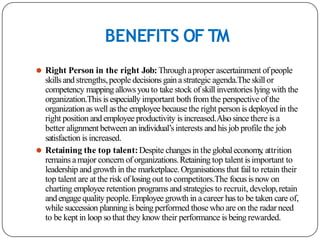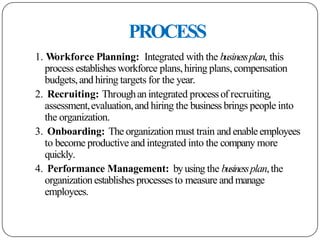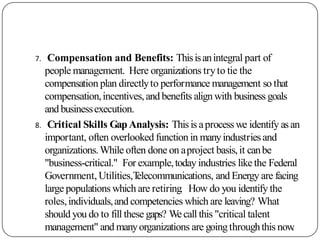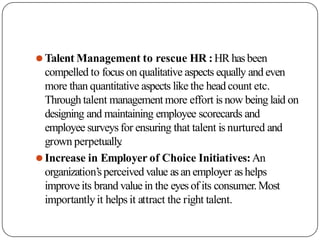TM SHIVANI.pptx
- 1. PRESENTED BY : SHIVANI VINDHANE ROLL NO : 65 GUIDED BY : DR. SUNITA SHAH TALENTMANAGEMENT
- 2. DEFINING TALENT ‘Talent consists of those individuals who can make adifference to organisationalperformance, either through their immediate contribution or in the longer term bydemonstrating the highest levels of potential’ Accordingto McKinsey , talent is the sum of ⚫ aperson’sabilities, ⚫ his or her intrinsicgifts, ⚫ skills, knowledge, experience , ⚫ intelligence, ⚫ judgment,attitude, character, drive, ⚫ his or her abilityto learn and grow
- 3. TALENT MANAGEMENT Aconscious, deliberate approach undertaken to attract, develop and retain people with the aptitude and abilities to meet current and future organisational needs. TALENT=COMPETENCE+COMMITMENT+CONTRIBUTION
- 4. PURPOSE OF TM ⚫ To compete effectively in a complex and dynamic environment to achieve sustainable growth ⚫ T o develop leadersfor tomorrow from within anorganization ⚫ T o maximize employee performance as a unique source of competitive advantage ⚫ T o empower employees: Cut down on highturnover rates Reduce the cost of constantly hiring new people to train
- 5. BENEFITS OF TM ⚫ Right Person in the right Job:Throughaproper ascertainment ofpeople skills and strengths,people decisions gainastrategic agenda.The skill or competency mapping allowsyouto take stock of skill inventories lyingwith the organization.This is especially important both from the perspective of the organizationaswell asthe employee because the right person is deployed in the right position and employee productivity is increased.Alsosince there is a better alignment between an individual’sinterests and his job profile the job satisfaction is increased. ⚫ Retaining the top talent:Despite changesin the globaleconomy , attrition remains amajor concern of organizations.Retaining top talent is important to leadership and growth in the marketplace.Organisations that failto retain their top talent are at the risk of losing out to competitors.The focusis now on charting employee retention programs and strategies to recruit, develop,retain andengagequality people.Employeegrowth in acareer hasto be taken care of, while succession planning is being performed those who are on the radar need to be kept in loop so that they know their performance is being rewarded.
- 6. Contd.. ⚫ Better Hiring:The quality of anorganizationis the quality of workforce it possesses.The best wayto have talent at the top is have talent at the bottom. No wonder then talent management programs and trainings,hiring assessments havebecome an integral aspect of HR processes nowadays. ⚫ Understanding Employees Better: Employee assessments give deep insightsto the management about their employees.Their development needs, career aspirations,strengths and weaknesses,abilities,likes and dislikes.It is easier therefore to determine what motivates whom and this helps alot Job enrichment process. ⚫ Better professional development decisions: Whenanorganizationgets to know who its high potential is,it becomes easier to invest in their professional development.Sincedevelopment calls for investment decisions towards learning,training and development of the individual either for growth, succession planning,performance management etc, an organizationremains bothered where to make this investment and talent management just make this easier for them.
- 7. FOCUSSES OF TM APPROACHES ⚫ Recruitment - ensuring the right people are attracted to the organisation. ⚫ Retention - developing and implementing practices that reward and support employees. ⚫ Employee development - ensuring continuous informal and formal learning anddevelopment. ⚫ Leadership and "high potential employee" development - specific development programs for existingand future leaders. ⚫ Performance management - specific processes that nurture and support performance, includingfeedback/measurement. ⚫ Workforce planning - planning for business and general changes,including the older workforce and current/future skillsshortages. ⚫ Culture - development of apositive,progressive andhigh performance "way of operating".
- 8. TM - A PROCESS
- 9. 1. Workforce Planning: Integrated with the businessplan, this process establishes workforce plans,hiring plans,compensation budgets,and hiring targets for the year. 2. Recruiting: Throughan integrated processof recruiting, assessment,evaluation,and hiring the business brings people into the organization. 3. Onboarding: The organization must train and enable employees to become productive and integrated into the company more quickly. 4. Performance Management: byusing the businessplan,the organization establishes processes to measure and manage employees. PROCESS
- 10. 5. Training and Performance Support: Thisisacritically important function.Learning and development programs is provided to all levelsof the organisation.Thisfunction itself is evolving into acontinuous support function. 6. Succession Planning: as the organization evolves and changes, there is acontinuous need to move people into new positions. Succession planning, averyimportant function, enables managers and individuals to identify the right candidatesfor a position. This function also must be aligned with the business planto understand and meet requirements for key positions 3-5 years out. While this is often aprocess reserved for managers and executives,it is more commonly applied across the organization.
- 11. 7. Compensation and Benefits: Thisisanintegral part of people management. Here organizations tryto tie the compensation plan directlyto performance management so that compensation,incentives,and benefits align with business goals and businessexecution. 8. Critical Skills GapAnalysis: This is aprocess we identify asan important, often overlooked function in manyindustriesand organizations.While often done on aproject basis,it canbe "business-critical." For example,today industries like the Federal Government, Utilities,T elecommunications, and Energy are facing large populations which are retiring. How do you identify the roles,individuals,and competencies which are leaving? What should you do to fill these gaps? Wecall this "critical talent management" and manyorganizations are goingthroughthis now .
- 12. RECENT TRENDS IN TM ⚫ T alentW ar ⚫ Technology ⚫ Increase in Employer of Choice Initiatives ⚫ PromotingTalent Internally ⚫ Population
- 13. RECENT TRENDS IN TM ⚫ Talent War:Findingandretaining the best talent isthe most difficultaspect of HR management.HR survey consultanciesare one in their view that organizationsgloballyare facingadearth of talented employeesand it’s often more difficult to retain them. Further research has alsoshown that there is clear link between talent issues and overall productivity . ⚫ T echnology andT alent Management:T echnology is increasinglygetting introduced into people development. Online employee portals have become common place in organizations to offer easy accessto employees to various benefits and schemes.In addition employeescan also managetheir careers through these portals and it alsohelps organizations understand their employees better.
- 14. ⚫Talent Management to rescue HR :HR hasbeen compelled to focus on qualitative aspects equally and even more than quantitative aspects like the head count etc. Through talent management more effort is now being laid on designing and maintaining employee scorecards and employee surveys for ensuring that talent is nurtured and grown perpetually . ⚫Increase in Employer of Choice Initiatives:An organization’sperceived value as an employer ashelps improveits brand value in the eyes of its consumer.Most importantlyit helps it attract the right talent.
- 15. ⚫ Promoting Talent Internally: Anindividualishired, whenthere isafit between his abilities or skills and the requirements of the organization.The next step is enabling learning and development of the same so that he/she stayswith the organization.Thisisemployeeretention.Anenabledor empoweredmeans anempowered organization.It is alsoof interest to organizations to know their skills inventories and then develop the right individual for succession planning internally. ⚫ Population Worries Globally: Worldpopulationsare either youngor aging. Forexample, stats have it that by 2050 60%ofEurope’s workingpopulation will be over 60! On the other hand acountry like India can boast of ayoung population in the coming and present times.Population demographics are thus a disturbing factor for people managers.Still more researches havepredicted that demographic changesin United States will lead to shortage of 10 million workersin the near future!















